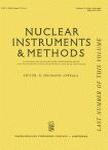版权所有:内蒙古大学图书馆 技术提供:维普资讯• 智图
内蒙古自治区呼和浩特市赛罕区大学西街235号 邮编: 010021

作者机构:Program on Nuclear Studies in Engineering School of Engineering and Applied Science Princeton University Princeton N.J. 08540 U.S.A.
出 版 物:《NUCLEAR INSTRUMENTS & METHODS》
年 卷 期:1967年第55卷第2期
页 面:238-+页
核心收录:
基 金:National Science Foundation, NSF United States Atomic Energy Commission, AEC
摘 要:The pulse height response of silicon surface barrier detectors was measured for median light and heavy fission fragments at average energies from 7 to 102 MeV. The fragment energies were determined by a time-of-flight technique. Comparison of the detectors response to fission fragments with that to alpha particles yielded Δ, the pulse height defect. The results indicate that an appreciable fraction of Δ is due to recombination losses within the ionization column produced by the fragment. The contribution to Δ from this cause decreases approximately linearly with fragment energy. In the energy realm where nonionizing nuclear collisions occur, Δ decreases sharply at initial energies below 25 MeV. An empirical energy calibration method proposed by Schmitt et al. for fission fragments with undergraded energies gave good agreement with the time-of-flight data in the energy range 25–100 MeV. A further empirical procedure is proposed for energies below 25 MeV.